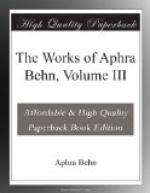In Sir Patient Fancy (1678), Lady Knowell’s late husband, a rank Puritan, is said to have been ‘a great Ay and No Man i’th’ City, and a painful promoter of the good Cause.’
p. 109 Twins. Vide note (p. 319, Amorous Twire), Vol. II, p. 440, The Feigned Courtezans.
p. 113 gives Julia the Letter. Mrs. Behn took the hint for this device from L’Ecole des Maris, ii, XIV, where Isabella feigning to embrace Sganarelle gives her hand to Valere to kiss.
p. 116 Just-au-corps. ’A sort of jacket called a justacorps came into fashion in Paris about 1650. M. Quicherat informs us that a pretty Parisienne, the wife of a maitre de comptes named Belot, was the first who appeared in it. In a ballad called The New-made Gentlewoman, written in the reign of Charles II, occurs the line “My justico and black patches I wear”. Mr. Fairholt suggested that justico may be a corruption of juste au corps.—Planche’s Cyclopedia of Costume, Vol. I, p. 318. Pepys, 26 April, 1667, saw the Duchess of Newcastle ‘naked-necked, without anything about it, and a black just-au-corps’. cf. Dryden’s Limberham; or, The Kind Keeper (1678), iv, I: ’Aldo. Give her out the flower’d Justacorps with the petticoat belonging to’t.’
p. 116 Towers, The tower at this time was a curled frontlet of false hair. cf. Crowne’s The Country Wit (1675), Act ii, II, where Lady Faddle cries to her maid, ’run to my milliner’s for my gloves and essences ... run for my new towre.’ Shadwell, The Virtuoso (1676), Act iii, mentions ‘Tires for the head, locks, tours, frouzes, and so forth’. The Debauchee (1677), Act ii, I: Mrs. Saleware speaks of buying ’fine clothes, and tours, and Points and knots.’ The Younger Brother (1696), Act v, the last scene, old Lady Youthly anxiously asks her maid, ’is not this Tour too brown?’ During the reign of Mary II and particularly in the time of Anne a Tower meant almost exclusively the high starched head-dress in vogue at that period.
p. 116 beat the hoof. To go packing; to trudge off on foot. Dic. Canting Crew (1690), ‘Hoof it or beat it on the Hoof—to walk on foot.’ Pad the hoof is a yet commoner expression. These and similar slang are still much used.
p. 117 finical. According to the N.E.D. the use of finical as a verb is a nonce word only found in this passage.
p. 119 lead Apes in Hell. To die an old maid. A very common expression. It will be remembered that Beatrice had something to say on the subject. —Much Ado About Nothing, Act ii, I.
p. 122 Docity. Gumption, cf. note (p. 340), Vol. II, p. 441, The Feign’d Curtezans.




